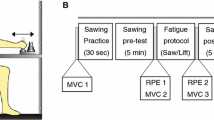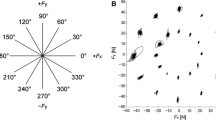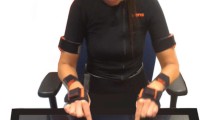Abstract
Proper movement timing is essential to the successful execution of many motor tasks and may be adversely affected by muscle fatigue. This study quantified how muscle fatigue affected task performance during a repetitive upper extremity task. A total of 14 healthy young adults pushed a low load back and forth along a low-friction horizontal track in time with a metronome until volitional exhaustion. Kinematic, force, and electromyography (EMG) data were measured continuously throughout the task. The first and last 3.5 min were analyzed to represent “early” and “late” fatigue. Means and standard deviations of movement distance, speed, and timing errors were computed. We also decomposed variations in movement distance and speed into deviations that directly affected achieving the task goal and those that did not, by identifying the goal equivalent manifold (GEM) of all valid solutions to this task. Detrended fluctuation analysis was used to quantify the temporal persistence in each time series. Principle components analysis provided a direct measure of alignment with the GEM. Median power frequencies of the EMG significantly decreased in six of the nine muscles tested indicating that subjects did fatigue. However, there were no differences in the means or variability of movement distance, speed, or timing errors. Thus, subjects maintained overall performance despite fatigue. Subjects applied slightly higher peak handle forces when they were fatigued (P = 0.032). Muscle fatigue caused significant reductions in the temporal persistence of movement speed (P = 0.037) and timing errors (P = 0.046), indicating that subjects corrected errors more quickly when fatigued. Mean deviations and variability perpendicular to the GEM were much smaller than variability along the GEM (P < 0.001). Deviations perpendicular to the GEM were also corrected much more rapidly than those along the GEM (P < 0.001). Subjects aligned themselves very closely (<±7°), but not exactly (P < 0.001), with the GEM. These measures were not significantly affected by muscle fatigue. Overall, these results indicated that subjects altered their biomechanical movement patterns in response to muscle fatigue, but did so in a way that specifically preserved the goal relevant features of task performance.











Similar content being viewed by others
References
Arihara M, Sakamoto K (1999) Contribution of motor unit activity enhanced by acute fatigue to physiological tremor of finger. Electromyogr Clin Neurophysiol 39:235–247
Aschersleben G (2002) Temporal control of movements in sensorimotor synchronization. Brain Cogn 48:66–79
Bigland-Ritchie B, Woods JJ (1984) Changes in muscle contractile properties and neural control during human muscular fatigue. Muscle Nerve 7:691–699
Billaut F, Basset FA, Falgairette G (2005) Muscle coordination changes during intermittent cycling sprints. Neurosci Lett 380:265–269
Bock O (1993) Early stages of load compensation in human aimed arm movements. Behav Brain Res 55:61–68
Borg GA (1974) Perceived exertion. Exerc Sport Sci Rev 2:131–153
Borg GA (1982) Psychophysical bases of perceived exertion. Med Sci Sports Exerc 14:377–381
Bove M, Tacchino A, Novellino A, Trompetto C, Abbruzzese G, Ghilardi MF (2007) The effects of rate and sequence complexity on repetitive finger movements. Brain Res 1153:84–91
Chen Y, Ding M, Kelso JAS (1997) Long memory processes (1/f α Type) in human coordination. Phys Rev Let 79:4501–4504
Corbeil P, Blouin J, Begin F, Nougier V, Teasdale N (2003) Perturbation of the postural control system induced by muscular fatigue. Gait Posture 18:92–100
Corcos DM, Jiang HY, Wilding J, Gottlieb GL (2002) Fatigue induced changes in phasic muscle activation patterns for fast elbow flexion movements. Exp Brain Res 142:1–12
Côté JN, Mathieu PA, Levin MF, Feldman AG (2002) Movement reorganization to compensate for fatigue during sawing. Exp Brain Res 146:394–398
Cusumano JP, Cesari P (2006) Body-goal variability mapping in an aiming task. Biol Cybern 94:367–379
Daffertshofer A, Lamoth CJC, Meijer OG, Beek PJ (2004) PCA in studying coordination and variability: a tutorial. Clin Biomech 19:415–428
DeLuca CJ (1984) Myoelectrical manifestations of localized muscular fatigue in humans. Crit Rev Biomed Eng 11:251–279
Ding M, Chen Y, Kelso JAS (2002) Statistical analysis of timing errors. Brain Cogn 48:98–106
Dingwell JB, Cusumano JP (2000) Nonlinear time series analysis of normal and pathological human walking. Chaos 10:848–863
Dingwell JB, Kang HG (2007) Differences between local and orbital dynamic stability during human walking. J Biomech Eng 129:586–593
Farina D, Fattorini L, Felici F, Filligoi G (2002) Nonlinear surface EMG analysis to detect changes of motor unit conduction velocity and synchronization. J Appl Physiol 93:1753–1763
Gandevia SC (2001) Spinal and supraspinal factors in human muscle fatigue. Physiol Rev 81:1725–1789
Gates DH, Su JL, Dingwell JB (2007) Possible biomechanical origins of the long-range correlations in stride intervals of walking. Phys A Stas Med Appl 380:259–270
Goerlick M, Brown JMM, Groeller H (2003) Short-duration fatigue alters neuromuscular coordination of trunk musculature: implications for injury. Appl Ergon 34:317–325
Gordon AM, Westling G, Cole JK, Johansson RS (1993) Memory representations underlying motor commands used during manipulation of common and novel objects. J Neurophysiol 69:1789–1796
Hausdorff JM, Peng CK, Ladin Z, Wei JY, Goldberger AL (1995) Is walking a random walk? Evidence for long-range correlations in stride interval of human gait. J Appl Physiol 78:349–358
Heuer H, Schulna R, Luttmann A (2002) The effects of muscle fatigue on rapid finger oscillations. Exp Brain Res 147:124–134
Hof AL (1996) Scaling gait data to body size. Gait Posture 4:222–223
Hunter SK, Duchateau J, Enoka RM (2004) Muscle fatigue and the mechanisms of task failure. Exerc Sport Sci Rev 32:44–49
Jaric S, Blesic S, Milanovic S, Radovanovic S, Ljubisavljevic M, Anastasijevic R (1999) Changes in movement final position associated with agonist and antagonist muscle fatigue. Eur J Appl Physiol 80:467–471
Konrad P (2005) The ABC of EMG: a practical introduction to kinesiological electromyography, Noraxon, Inc
Latash ML, Scholz JP, Schöner G (2002) Motor control strategies revealed in the structure of motor variability. Exerc Sport Sci Rev 30:26–31
Lorist MM, Kernell D, Meijman TF, Zijdewind I (2002) Motor fatigue and cognitive task performance in humans. J Physiol 545:313–319
Lucidi CA, Lehman SL (1992) Adaptation to fatigue of long duration in human wrist movements. J Appl Physiol 73:2596–2603
MacIsaac D, Parker PA, Scott RN (2001) The short-time Fourier transform and muscle fatigue assessment in dynamic contractions. J Electromyogr Kinesiol 11:439–449
Madigan ML, Pidcoe PE (2003) Changes in landing biomechanics during a fatiguing landing activity. J Electromyogr Kinesiol 13:491–198
Maraun D, Rust HW, Timmer J (2004) Tempting long-memory—on the interpretation of DFA results. Nonlinear Processes Geophys 11:495–503
Nussbaum MA, Clark L, Kirst M, Rice K (2001) Fatigue and endurance limits during intermittent overhead work. AIHA J 62:446–456
O’Boyle DJ, Freeman JS, Cody FWJ (1996) The accuracy and precision of timing of self-paced, repetitive movements in subjects with Parkinson’s disease. Brain 119:51–70
Oldfield RC (1971) The assessment and analysis of handedness: the Edinburgh inventory. Neuropsychologia 9:97–113
Peng CK, Buldyrev SV, Havlin S, Simons M, Stanley HE, Goldberger AL (1994) Mosaic organization of DNA nucleotides. Phys Rev E 49:1685–1689
Peng CK, Havlin S, Stanley HE, Goldberger AL (1995) Quantification of scaling exponents and crossover phenomena in nonstationary heartbeat time series. Chaos 5:82–87
Peng CK, Mietus J, Hausdorff JM, Havlin S, Stanley HE, Goldberger AL (1993) Long-range anticorrelations and non-Gaussian behavior of the heartbeat. Phys Rev Let 70:1343–1346
Sainburg RL, Ghez C, Kalakanis D (1999) Intersegmental dynamics are controlled by sequential anticipatory, error correction, and postural mechanisms. J Neurophysiol 81:1045–1056
Scholz JP, Schöner G (1999) The uncontrolled manifold concept: identifying control variables for a functional task. Exp Brain Res 126:289–306
Schöner G, Scholz JP (2007) Analyzing variance in multi-degree-of-freedom movements: uncovering structure versus extracting correlations. Motor Control 11:259–275
Selen LPJ, Beek PJ, van Dienn JH (2007) Fatigue-induced changes of impedance and performance in target tracking. Exp Brain Res 181:99–108
Strange AJ, Berg WP (2007) Fatigue-induced adaptive changes of anticipatory postural adjustments. Exp Brain Res 178:49–61
van Duinen H, Renken R, Maurits N, Zijdewind I (2007) Effects of motor fatigue on human brain activity, an fMRI study. NeuroImage 35:1438–1449
Voge KR, Dingwell JB (2003) Relative timing of changes in muscle fatigue and movement coordination during a repetitive one-hand lifting task. In: Proceedings of 25th international conference of IEEE EMBS, Cancun
von Tscharner V (2002) Time-frequency and principal-component methods for the analysis of EMGs recorded during a mildly fatiguing exercise on a cycle ergometer. J Electromyogr Kinesiol 12:479–492
Wilder DG, Aleksiev AR, Magnusson ML, Malcolm PH, Spratt KF, Goel VK (1996) Muscular response to sudden load: a tool to evaluate fatigue and rehabilitation. Spine 21:2628–2639
Winter DA (2005) Biomechanics and motor control of human movement, 3rd edn. Wiley, New York
Acknowledgments
Funding for this project was provided by grant #EB003425 from the National Institutes of Health. The authors thank Dr. Joseph P. Cusumano for many insightful discussions and comments on this manuscript.
Author information
Authors and Affiliations
Corresponding author
Rights and permissions
About this article
Cite this article
Gates, D.H., Dingwell, J.B. The effects of neuromuscular fatigue on task performance during repetitive goal-directed movements. Exp Brain Res 187, 573–585 (2008). https://doi.org/10.1007/s00221-008-1326-8
Received:
Accepted:
Published:
Issue Date:
DOI: https://doi.org/10.1007/s00221-008-1326-8




